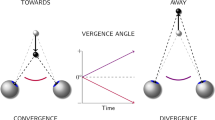Abstract
Classically, the primary tool for quantifying the dynamics of vergence and other eye movements has been the main sequence. The main sequence is a plot of peak velocity versus response amplitude and is particularly useful for comparing the dynamics of a large number of eye movements over a range of response amplitudes. However, the main sequence represents only the equivalent first-order behavior of a response and does not describe its dynamics in detail. Since the main sequence is based on only two points on the dynamic trajectory, it is sensitive to measurement artifacts and noise. A new methodology is presented which quantifies the equivalent second-order dynamics of eye movements using a larger region of the transient response. These new indexes were applied to vergence eye movements and were found to differentiate between subtle, but important differences in movement dynamics. © 1999 Biomedical Engineering Society.
PAC99: 4266Ew, 8719St
Similar content being viewed by others
REFERENCES
Alvarez, T. L., J. L. Semmlow, and W. Yuan. Closely-spaced, fast dynamics movements in disparity vergence. J. Neurophysiol. 79:37–44, 1998.
Bahill, T. A., M. R. Clark, and L. Stark. The main sequence, a tool for studying human eye movements. Math. Biosci. 24:191–203, 1975.
Bahill, A. T., J. S. Kallman, and J. E. Lieberman. Frequency limitations of the two-point central difference differentiation system. Biol. Cybern. 45:1–4, 1982.
Bahill, A. T., and L. Stark. The trajectories of saccadic eye movements. Sci. Am. 240:108–117, 1979.
Chen, T., Y.-F. Chen, C. H. Lin, and T. T. Tsai. A novel quantification analysis for saccadic eye movements. Ann. Biomed. Eng. (to be published).
Collewijn, H., C. J. Erkelens, and R. M. Steinman. Voluntary binocular gaze-shifts in the plane of regard; Dynamics of version and vergence. Vision Res. 35:335–338, 1995.
Cova, A. C., and H. L. Galiana. A bilateral model integrating vergence and the vestibulo-ocular reflex. Exp. Brain Res. 107:435–452, 1996.
Gamlin, P. D. R., and L. E. Mays. Dynamic properties of medial rectus motoneurons during vergence eye movements. J. Neurophysiol. 67:64–74, 1992.
Horng, J.-L., J. L. Semmlow, G. K. Hung, and K. J. Ciuffreda. Dynamic asymmetries in disparity vergence. Vision Res. 38:1254–1261, 1998.
Hung, G. K., K. J. Ciuffreda, J. L. Semmlow, and J.-L. Horng. Vergence eye movements under natural viewing conditions. Invest. Ophthalmol. Visual Sci. 35:3486–3492, 1994.
Hung, G. K., J. L. Semmlow, and K. J. Ciuffreda. A dualmode dynamic model of the vergence eye movement system. IEEE Trans. Biomed. Eng. 33:1021–1028, 1986.
Jones, R. Fusional vergence; Sustain and transient components. Am. J. Optom. Physiol. Opt. 57:640–664, 1980.
Jones, R., and G. L. Stephen. Horizontal fusional amplitudes. Invest. Ophthalmol. Visual Sci. 30:1638–1642, 1989.
Krishnan, V. V., and L. Stark. A heuristic model of the human vergence eye movement. IEEE Trans. Biomed. Eng. 24:44–49, 1977.
Mays, L. E., J. D. Porter, P. D. R. Gamlin, and C. A. Tello. Neural control of vergence movements; Neurons encoding vergence velocity. J. Neurophysiol. 56:1007–1021, 1986.
Mitchell, D. E. Properties of stimuli eliciting vergence eye movements and stereopsis. Vision Res. 10:145–162, 1970.
Ogle, K. N., T. G. Martens, and J. A. Dyer. Binocular Vision and Fixation Disparity. Philadelphia, PA: Lea and Febiger, 1967.
Rashbass, G., and G. Westheimer. Disjunctive eye movements. J. Physiol. (London) 159:339–360, 1961.
Robinson, D. A. The mechanics of human saccadic eye movement. J. Physiol. (London) 174:245–264, 1964.
Rosenfield, M., and K. J. Ciuffreda. The effects of surround propiquity on the open-loop accommodation response. Invest. Ophthalmol. Visual Sci. 32:142–147, 1991.
Semmlow, J. L., G. K. Hung, and K. J. Ciuffreda. Quantitative assessment of disparity vergence components. Invest. Ophthalmol. Visual Sci. 27:558–564, 1986.
Semmlow, J. L., G. K. Hung, F. Horng, and K. J. Ciuffreda. Disparity vergence eye movements exhibit preprogrammed motor control. Vision Res. 34:1335–1343, 1994.
Semmlow, J. L., G. K. Hung, J.-L. Horng, and K. J. Ciuffreda. The initial control of disparity vergence eye movements. Invest. Ophthalmol. and Visual Sci. 13:48–55, 1993.
Slotine, J.-J. E., and W. Li. Applied Nonlinear Control. Englewood Cliffs, NJ: Prentice-Hall, 1991, pp. 17–39.
Toates, F. M., Vergence eye movements. Doc. Ophthalmol. 37:153–217, 1974.
Westheimer, G., and D. E. Mitchell. The sensory stimulus for disjunctive eye movements. Vision Res. 9:749–755, 1969.
Zuber, B., and L. Stark, Dynamical characteristics of the fusional vergence eye-movement system. IEEE Trans. Syst. Sci. Cybern. 4:72–79, 1968.
Author information
Authors and Affiliations
Rights and permissions
About this article
Cite this article
Alvarez, T.L., Semmlow, J.L., Yuan, W. et al. Dynamic Details of Disparity Convergence Eye Movements. Annals of Biomedical Engineering 27, 380–390 (1999). https://doi.org/10.1114/1.162
Issue Date:
DOI: https://doi.org/10.1114/1.162




